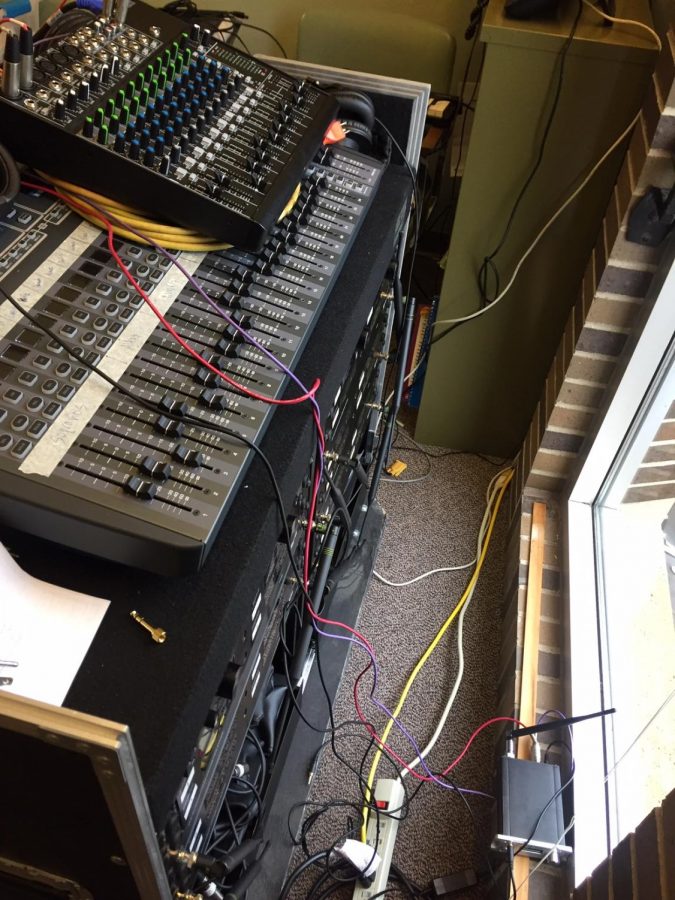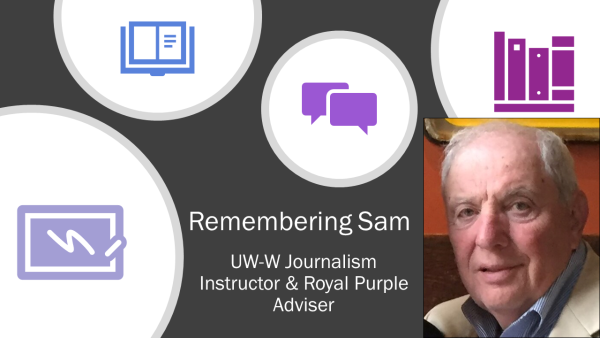Choir practice in the car
Music Department gets creative with social distancing
The UW-Whitewater’s Vocal Jazz ensemble used this equipment for years, indoors. However, now the Choir uses the Mixers, wireless microphone receiver, and a FM transmitter for parking lot rehearsals. The FM transmitter is on the windowsill near the bottom.
September 13, 2020
UW-Whitewater’s choir students dedicate themselves to music. And in a pandemic those students persevere with creative practices that allow for social distancing.
This semester they practice in the parking lot between Laurentide Hall and the Greenhill Center of the Arts in a roped off area that will help ensure each other’s health and safety.
“I like Whitewater’s choir, because when I sing it releases my stress. I learn more compared to my high school. The songs are harder, but now I can grow,” said soprano Natalie Hirsch.
Forty-eight choir students practice outside, on most Mondays through Thursdays unless told otherwise. They stand in an 80-foot circle, and disperse themselves into five smaller groups, according to associate professor Robert Gehrenbeck, choral ensemble director.
They separate themselves six to eight feet apart into soprano one, alto one, alto two, tenor, and bass groups. These smaller groups help reduce aerosol transmission, and keep others safe from potential COVID-19 droplets.
When they practice outside the breeze blows away harmful particles. The air takes the COVID-19 droplets and releases them into the atmosphere. However, if they practiced indoors they would need a larger space and extra safety equipment.
If they practice in the Young Auditorium they would need an empty room for at least 30 minutes, said Dr. Gehrenbeck. This way the air can circulate and the singers can stay safe. If any particles escaped, then they would disappear within the 30-minute break. Otherwise when the singers open their mouths to sing they could get exposed to COVID-19.
To prevent this, students wear a special singer’s mask that covers their nose and mouth. A thin metal band wraps over their mouths, and leaves extra room for singing.
“I prefer them over regular masks, because they are more comfortable. The masks do not stick to our mouths when we sing, or inhale. The masks are tight, and they project louder voice,” Gehrenbeck said.
The flattened top wraps over their mouths, and pops out like a duck bill. The masks strapped around their heads with four oval strings. They protect their safety, and it is easier to hear them sing.
The Music Department also created a parking lot practice with students’ vehicles. A wireless microphone receiver transmits to a sound mixer, and then sends signals to the 89.1 FM transmitter. Students can instantly hear in their own marked-off spaces without any delays.
When they sit in their vehicles, they can all sing into their wireless microphones. They can still connect together, social distance and practice at the same time.
Other times, the ensembles rehearse at the Community Engagement Center. They use a large room and social distance on the loading dock. The Music Department faculty and staff are doing whatever it takes to keep students learning throught the pandemic. Many sacrificed their summer working unpaid hours and thinking up innovative ways to keep students singing.
“We could crash, and burn, but we need to find something deeper to get through this problem,” said lecturer Susan Chandler. “I am their role model, and if I crumble, they will too. I have got to help them get through it.”













